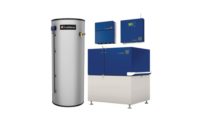The terms “cogeneration” and Combined Heat and Power (CHP) are synonyms for the simultaneous production of hot water and supplemental electricity for on-site use. So-called “MicroCHP solutions” (< 50 kW/hr) are often powered by an internal combustion engine, fuel cell or turbine. This makes them easy to install in a variety of commercial applications.
MicroCHP technology is a promising solution in regions where there is a substantial “spark spread.” That’s the difference between the cost of electricity and natural gas in a particular location. By using relatively low-cost natural gas to provide hot water solutions and supplemental electricity, a MicroCHP system enables a business to use less of the expensive electricity from the grid. Other opportunities exist where there is need to reduce grid dependency and improve grid reliability.
According to U.S. Department of Energy research, the spark spread is widest in California, New York, New England and Hawaii – plus a lot of surprising locations like New Mexico, central Florida, and a few spots in Nebraska and Montana.
MicroCHP technology is remarkably efficient. It avoids the transmission and distribution (T&D) losses that occur when electricity travels over power lines. The average T&D loss in the U.S. is now about 4.5 percent, but it can increase to 10 percent when the grid is burdened and temperatures are high. In addition, the average efficiency of fossil-fueled power plants in the U.S. is only about 33 percent. Two-thirds of the energy used to produce electricity at these plants is wasted as heat gets discharged into the atmosphere. In contrast, cogeneration systems can achieve extraordinary conversion efficiencies of 75 to 90 percent. Cogeneration reduces emissions of greenhouse gases and other air pollutants because less fuel is burned per unit of energy output and T&D losses are eliminated.
Businesses that would benefit most from MicroCHP technology have a high hot water load that lasts for extensive periods of time, e.g., hotels, hospitals, colleges, restaurants and swimming pools. Whether it’s a hotel in San Francisco, a college in upstate New York or a restaurant in Hawaii, MicroCHP technology can offer dramatic savings.
Lochinvar is already seeing multiple installations and immediate savings for colleges like Finger Lakes Community College and more unique rural farm applications.






